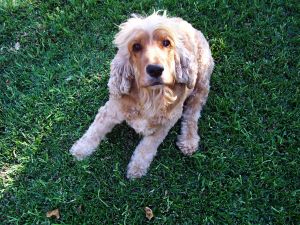 Everyone has a say in what they feel is the best diet for his or her dogs – dry food vs. wet food, human food or not. At either end of the food-debate spectrum are the all-meat proponents and no-meat proponents. Both factions have their fair share of reasons why their diets are best for dogs. But both arguments have their fare share of naysayers as well. So which is the best diet for a dog: the all-meat diet, or a no-meat diet?
Everyone has a say in what they feel is the best diet for his or her dogs – dry food vs. wet food, human food or not. At either end of the food-debate spectrum are the all-meat proponents and no-meat proponents. Both factions have their fair share of reasons why their diets are best for dogs. But both arguments have their fare share of naysayers as well. So which is the best diet for a dog: the all-meat diet, or a no-meat diet?
All-meat proponents are typically grouped with the raw-food movement. The raw food movement isn’t anything new. Racing greyhounds and sled dogs are often given raw foods to help maintain astounding levels of energy. But there was a push for raw foods more commercially in 1993, when Australian veterinarian Ian Billingshurst introduced BARF – Bones and Raw Food diet, or Biologically Appropriate Raw Food. Billingshurst suggested that adult dogs would thrive on a diet of foods that their predecessors (pre-domestication) ate: raw, meaty bones and vegetable scraps. Grain-based commercial pet foods were harmful, he suggested.
But the FDA and many mainstream veterinarians disagree, mainly due to the risk of these raw diets.
Despite some opposition, proponents of the raw-food movement swear by it. They claim that the upside of a raw food diet is that a dog can enjoy shinier coats, healthier skin, cleaner teeth, higher energy levels, and smaller stools.
But there are risks to this raw-food diet, including the dangers of bacteria (to humans and dogs), an unbalanced diet, and the potential that dogs will choke on whole bones.
On the other side of the spectrum are those who believe that their dogs can become vegetarians.
Many human vegetarians want their dogs to share their diet, and so they decide to eliminate all meats from a dog’s life. Celebrity Alicia Silverstone’s dogs are vegetarian (which, she claims, has helped reduce the dogs’ flatulence). Proponents of a doggie vegetarian diet claim that the ingredients inside animal-inclusive dog foods are horrifying, specifically, that they feature meat from the “4 Ds” – dead, dying, diseased, or disabled animals. Also, many commercial dog foods include meat byproducts, which oftentimes is the equivalent of slaughterhouse waste. By choosing a no-meat diet, you are eliminating potentially harmful meat products from your dog’s diet, proponents claim.
But opponents of this movement remind us that dogs, like humans, need a certain level of protein just not possible in a plant-only diet. The Association of American Feed Control Officials claims that an adult dog’s diet should include 18% protein. And more specifically, certain proteins have different levels of amino acids, meaning that not all proteins are created equal. Providing your dog with the “right” proteins becomes much more difficult if you’re only providing a plant-based diet.
Vets are in disagreement over this movement. Some argue that it’s simply unnatural for a dog to be a vegetarian, while others argue that so long as the diet is balanced with the right kinds of protein, there is nothing wrong with this approach.
Dogs, like humans, are omnivores (unlike cats who are carnivores). They can survive on a diet of either plant or animal origin if it’s balanced and diverse. It seems a diet of all meat leaves a gaping hole in a dog’s nutrition intake, as does a diet of no-meat. Can it actually be possible to healthily keep your dog on either end of the spectrum, or is it best to reside in the happy medium?






For any animal, including humans, the healthiest diet is what they have evolved to eat, though both omnivores for dogs meat has been a more important part of their diet through history. A dog’s natural diet would be around 75% meat also it wouldn’t include much if any grains or cereals and this is why they cause health problems. Burns Egg, Brown Rice and vegetables at least includes animal derived protein so is the best option if for some reason your dog can’t eat meat but it isn’t ideal. Sensitive dogs will often have trouble with Beef of course but poultry and fish are a better option to try in this case rather than going for a meat free diet. Anyone who is having trouble with their dog having sensitivity to some types of meat could take a look at Bozita wet foods which have a wide range of different meat types.
From the Sled Dog Action Coalition: http://www.helpsleddogs.org/remarks-abuseinkennels.htm
Pre-race Iditarod vet check finds Salmonella in 69 percent of the dogs:
“Twenty-six normal asymptomatic dogs representing 13 teams were sampled during a routine prerace veterinary inspection. Of these, Salmonella was isolated from 18/26 (69%).”
– Cantor, Glenn H.; Nelson, Stuart; Vanek, Jerome A.; Evermann, James F.; Eriks, Inge S.; Basaraba, Randall J. and Besser, Thomas E. “Salmonella shedding in racing sled dogs.”Journal of Veterinary Diagnostic Investigation : Official Publication of the American Association of Veterinary Laboratory Diagnosticians, Inc. 1997 (October);9(4):447-448.
Iditarod dogs have a high prevalence of Salmonella compared to other dogs:
“These results show a surprisingly high prevalence of Salmonella in Alaskan sled dogs compared to the prevalence reported in other dogs.”
– Cantor, Glenn H.; Nelson, Stuart; Vanek, Jerome A.; Evermann, James F.; Eriks, Inge S.; Basaraba, Randall J. and Besser, Thomas E. “Salmonella shedding in racing sled dogs.”Journal of Veterinary Diagnostic Investigation : Official Publication of the American Association of Veterinary Laboratory Diagnosticians, Inc. 1997 (October);9(4):447-448.
Salmonella shedding by dogs is a possible source of Salmonella infection in humans:
“The high prevalence of Salmonella reported here may have significant public health implications.”
– Cantor, Glenn H.; Nelson, Stuart; Vanek, Jerome A.; Evermann, James F.; Eriks, Inge S.; Basaraba, Randall J. and Besser, Thomas E. “Salmonella shedding in racing sled dogs”.Journal of Veterinary Diagnostic Investigation : Official Publication of the American Association of Veterinary Laboratory Diagnosticians, Inc. 1997 (October);9(4):447-448.
“Veterinarians and public health officials have recognized shedding salmonellae by dogs as a possible source of Salmonella infection for dog owners and their communities.”
– Finley, Rita; Ribble, Carl; Aramini; Vandemeer, Meredith; Popa, Maria; Litman, Marcus and Reid-Smith, Richard. “The risk of salmonellae shedding by dogs fed Salmonella-contaminated commercial raw food diets.” Canadian Veterinary Journal. 2007 January; 48(1): 69–75.
Tourists who visit Iditarod kennels may face significant public health risks:
“The study [“Salmonella shedding in racing sled dogs”] shows that while living in musher kennels, the majority of dogs carry the Salmonella organism, substantially more than in dogs in many other parts of the world. Some Iditarod mushers give tourists kennel tours (one cruise line gives a kennel tour as part of its tour package). As a result, tourists who visit Iditarod dog kennels may be subjecting themselves to significant public health risks and cruise lines that offer these tours could be culpable.”
– Veterinarian Nedim C Buyukmihci, V.M.D., email to Sled Dog Action Coalition on February 25, 2013
Comments are closed.